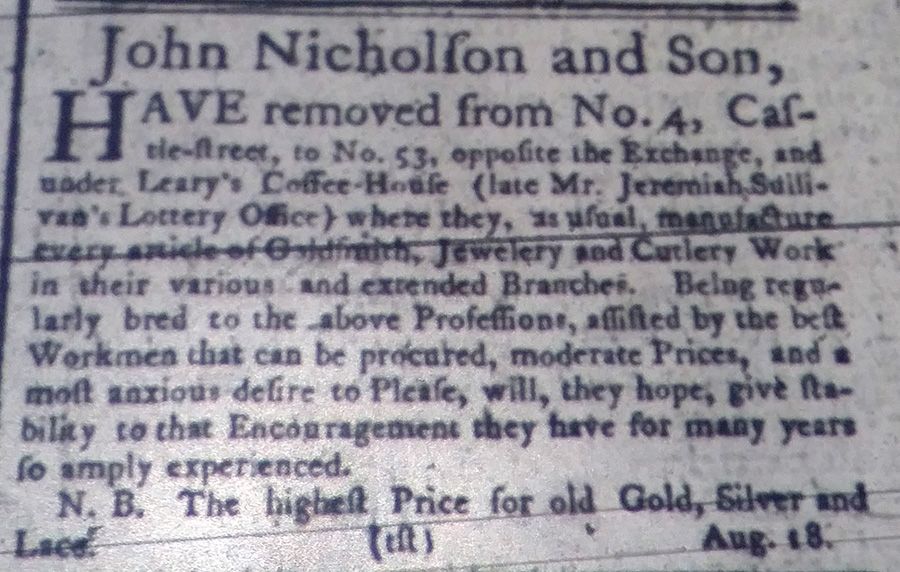
It’s difficult to equate this to the present Castle Street so while I don’t know exactly where No. 4 was without a visit to Cork to inspect old Wide Street Commissioners’ maps, No. 53 is easy to place as the Exchange was a well known building at the junction of Castle Street and North Main Street. Although there are suggestions that Castle Street was demolished in 1791, John Nicholson’s premises being the last to go, this may not be the case. Below are two old Cork City maps dating to 1774 and 1801 in which Castle Street looks relatively unchanged although there appears to be changes to buildings lying to the south. The 1815 drawing with its view as seen from North Main Street shows the Exchange and the buildings this end of Castle Street in their original state and intact.
1774 Map

1801 Map

1815 Drawing
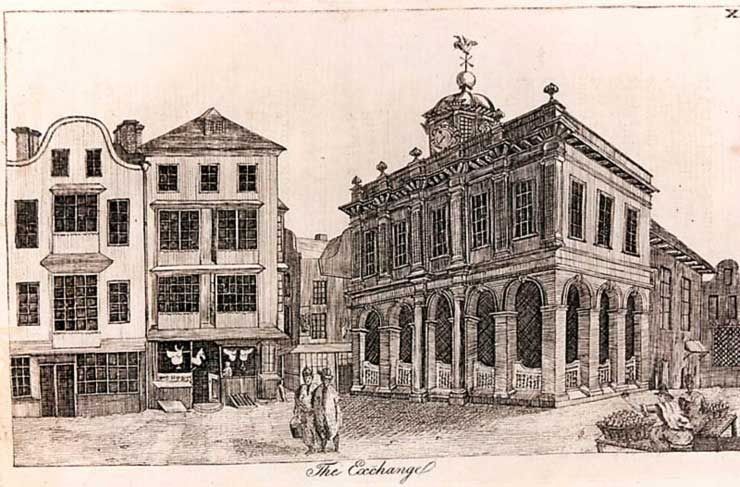
Examining Cork Council records I found this, “One of the earliest relevant entries in the Council Book is from 2 June, 1786, when the Corporation proposed the purchase of houses ‘from the Exchange to the entrance to the court house’ (Caulfield 1876, 1007—8). Purchasing of properties on the street continued during the 1780s and finally, in 1791, the Corporation issued directives on the new street, which was to be 32 feet wide and ‘of equal height to Mr John Shaw’s house’ 39 (ibid. 1067). The same year, the Corporation ordered that the returns on their leased property on Castle Street should go to the ‘Commission’ (the Wide Street Commissioners) to finance the purchase of what seems to have been one of the final buildings to be acquired for the widening of the street 40 (ibid. 1068). A Wide Street Commissioners’ map (Cork City Archives Collection, no. 6) depicts a Mr Collin’s premises where the Roundy public bar is today [the Roundy Bar is at the top end of Castle Street and runs around on to Grand Parade]. The map shows empty space at nos. 2 and 3 Castle Street, on which the Commissioners proposed to build. By 1869 (Ordnance Survey map) a structure had been built at no. 2 Castle Street, but no. 3 wasn’t erected until a later date. The line of the entrance into the meat market can still be seen preserved in the plan of the present-day buildings.”
It makes sense that if the Corporation demolished Nos. 2 & 3 in 1791 or thereabouts, No. 4, where John Nicholson had his business, may not have been safe or a good place to do business from, hence the move to No. 53 opposite the Exchange. The Architectural Heritage survey dates the present buildings on Castle Street to 1835-1875 so presumably this is when the remainder of Castle Street was regenerated. The Exchange was demolished in 1837. The building on the corner fronting on to North Main Street and Castle Street across the road from the Exchange was rebuilt circa 1860-80.
Another issue posed by this notice is that it says Nicholson & Son. I’m not sure there exists a reference to John Nicholson I and II being in partnership but given this notice, one must assume either they were or Nicholson & Son refers to John Nicholson II and his son, Nicholas, whom we know did form a partnership. Cork Silver and Gold makes mention of John Nicholson II as Goldsmith, Jeweller & Sword Cutler in 1791. The same book says of John Nicholson I, probably dead by 1805 and to be more precise, I discovered he died three years earlier on the 3rd December 1802.
To confuse the matter further, Douglas Bennett in Collecting Irish Silver, says John Nicholson I and Samuel Nicholson were in partnership from 1775-1797 and attributes the mark JSN in a rectangular reserve to John and Samuel. Given the scarcity of this mark it may have been a shorter partnership than intimated and by 1791 with the business in the name of Nicholson & Son, it seems Samuel must have departed by then. Samuel is a bit of a mystery man; he does not appear in Trade Directories of the time or in the list of Cork Freemen and it seems the source of Samuel is Cecil C. Woods in The Goldsmiths of Cork (1895) where he states, “About 1775, or 1780, John Nicholson appears to have had a partner whose initials were SN–probably his relation, Samuel Nicholson.” It’s interesting to note that John and Samuel did not use IN over SN as one would expect in a partnership but JSN, so if John Nicholson I and his son John Nicholson II were in a partnership, would they not have followed a similar formula and used JJN ? However, no such mark exists, nor does JN over JN so did they simply use JN to encompass both silversmiths during the Nicholson & Son era or was this, as I suggest above, the commencement of the John Nicholson II and Nicholas Nicholson partnership with their IN over NN mark?
Lucas’s Cork Directory 1787 shows an entry for Nicolson (John) Goldsmith and Cutler, Castle-street (note, no mention of Samuel) so the business was changed to Nicholson & Son between 1787 and 1791.
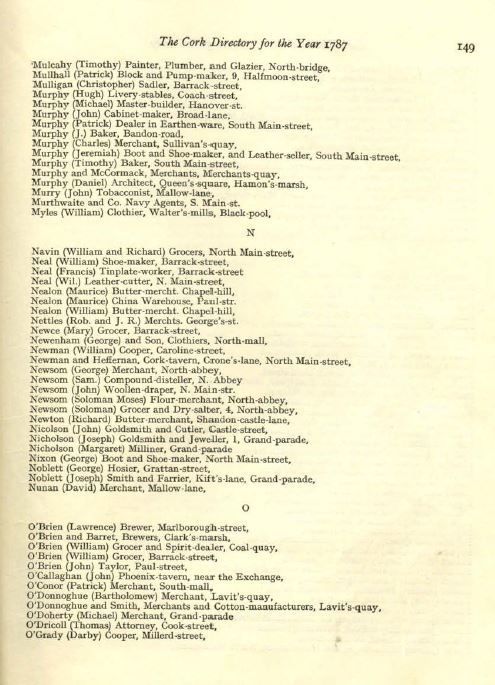
As mentioned above, John Nicholson I died in late 1802 and examining Holden’s Directory 1805-07, we can see an entry for Nicolson John and Nicholas, jewellers, silversmiths and sword cutlers, Grand Parade, referring to John Nicholson II and his son Nicholas.
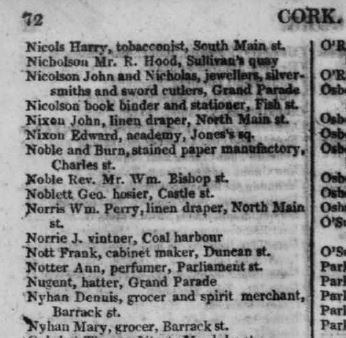
By the time William West’s Cork Directory 1809-10 was published, Nicholson Nich., Silversmith, Grand Parade was the only Nicholson entry so it’s clear he was working on his own by then with John Nicholson II not mentioned. Bennett implies the partnership lasted from 1797 to 1824 but clearly this was not the case. As yet, I haven’t traced a death notice for John Nicholson II.
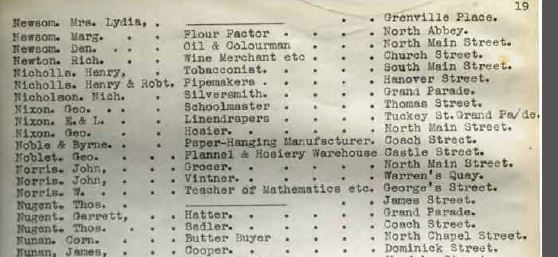
Pigot’s Directory (Cork City and County) 1824 reveals that Nicholas had by then given up as a Silversmith and was now working as a Watchmaker.
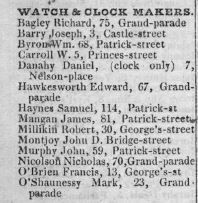
By the time Pigot’s Directory (Cork City & County) 1830 was completed, Nicholas had disappeared from the list of Trades and no other Nicholson’s are mentioned in the Directory.
So, as a final note, should we use the spelling Nicolson or Nicholson? It’s Nicolson in Lucas’s, Holden’s and Pigot’s Trade Directories and Nicholson in West’s Trade Directory. M.S.D. Westropp uses Nicolson in his article The Goldsmiths of Cork published in The Journal of the Cork Historical & Archaeological Society, 1906. In Bowen & O’Brien’s Cork Silver and Gold, it is shown as John Nicolson I (Nicholson) and John Nicolson II, while in Bennett’s Collecting Irish Silver it is John Nicholson (Nicolson) and Nicholas Nicholson (Nicolson). Cork Council spells it Nicholson in its list of Freemen as does Cecil C. Woods in his 1895 article The Goldsmiths of Cork. Personally, I believe it is Nicholson as one must assume the Nicholson’s knew how to spell their family name when submitting their advertisement to the Hibernian Chronicle and that we should now discount the spelling Nicolson when writing about the Nicholson family of silversmiths in Cork.
The various makers’ marks referred to above can be viewed here: http://www.925-1000.com/IProv_Nicholson.html
I’m sure there must be more material out there relating to this prominent family of Cork Silversmiths so please feel free to add comments, make corrections etc.
Gordon


